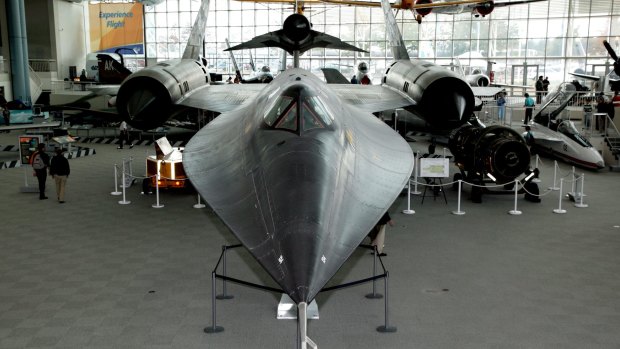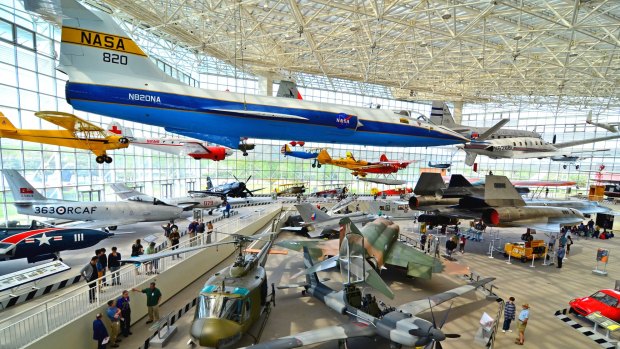This was published 4 years ago
Explore Seattle's Museum of Flight, celebrating the 50th anniversary of moon landing
By Julie Miller

The last remaining Lockheed Blackbird M-21 "Mothership".Credit: Alamy
In July 1969, the world watched in wonder as three astronauts stepped out of Apollo 11 onto the surface of the moon. Fifty years later, this giant leap for mankind is being celebrated at Seattle's Museum of Flight, with an exhibition featuring rare Smithsonian artefacts from that historic mission.
Running until September 2, 2019 – with a focus on the anniversary date – Destination Moon: The Apollo 11 Mission showcases the actual command module of Apollo 11, Columbia, allowing visitors a close-up view of the spacecraft as well as an interactive 3D tour created from high resolution scans.
The exhibition is enhanced with the Museum of Flight's own incredible collection of Space Race memorabilia, including a Soviet Sputnik satellite, a cosmonaut spacesuit and a full-sized Space Shuttle fuselage used for astronaut training.

The Museum of Flight in Seattle features aircraft from the dawn of flight to modern behemoths. Credit: Shutterstock.com
Strategically located overlooking the runways of Seattle's cargo airport and just a stone's throw from the Boeing factory, the Museum of Flight is the largest independent, non-profit air and space museum in the world, with a mind-boggling collection of more than 175 air and spacecraft as well as thousands of artefacts championing the dream of flight.
For aviation buffs and reluctant flyers alike, the Museum of Flight is a history-lesson in passion, featuring aircraft from the dawn of flight to modern behemoths including the Concorde, Air Force One and a prototype Boeing 747.
In the indoor Great Gallery, you can wander around the world's only remaining Lockheed M-21 Blackbird 'Mothership', which launched unmanned intelligence drones for the CIA. Capable of cruising at Mach 3, at an altitude of 85,000 feet (25,500 m - more than double a standard airliner's cruising altitude), the Blackbird was the fastest, highest-flying piloted jet in history. This one dates back to 1963 and the only other M-21 variant was lost in an accident.
You can also sit in the cockpit of a Blackbird reconnaissance plane, and giggle over a rather ridiculous flying car, the Taylor Aerocar III – a folly formerly owned by a travelling salesman who clearly liked to make an entrance.
Another surprise is the Boeing Red Barn, the birthplace of the beleaguered aircraft manufacturer. In 1975, this dilapidated two-storey wooden building was purchased for $US1 and barged downriver to the museum site, opening to the public after restoration in 1983. It now stands as a symbol of Seattle's ties to aviation history, recreating the factory shop floor with original machinery and photographs.
In the Personal Courage wing, aircraft from World War I and II are testament to the courage of men and women who battled in the skies, with personal stories resonating as profoundly as the impressive display of machinery.
Meanwhile, the expansive outdoor Aviation Pavilion is a nod to the modern obsession of "bigger, better, faster", with the opportunity to walk on-board classics such as a 787 Dreamliner and the West Coast's only Concorde. You can also take a peek inside Air Force One, a surprisingly unglamorous flying Oval Office that carried presidents Eisenhower, Kennedy, Johnson and Nixon on international diplomatic missions.
But arguably the biggest reality check is during a tour of the Space Shuttle Trainer, where you experience first-hand the stark and uncomfortable living conditions of astronauts on the International Space Station. From hanging sleeping bags to the claustrophobic cockpit, this training facility highlights the hardships of space flight, and the dedication required for men and women exploring the final frontier.
For instance – how do astronauts go to the bathroom in zero gravity? Well, their toilet is basically a suction cap that collects bodily waste to prevent it floating around – a system that makes the call of nature somewhat complicated.
As Buzz Aldrin wryly noted: "Neil Armstrong was the first man to walk on the moon. I am the first man to piss his pants on the moon."
TRIP NOTES
FLY
Delta Airlines flies daily from Sydney to LAX on the upgraded 777, featuring the new Premium Select cabin. Domestic transfers are available to Seattle. See delta.com
VISIT
Entry to the Museum of Flight costs $US25 for adults, $US16 for children. Shuttle Trainer tours are an extra $US20/$US15. Destination Moon runs until September 2, and costs an extra $US10 on top of general admission. See museumofflight.org
Sign up for the Traveller Deals newsletter
Get exclusive travel deals delivered straight to your inbox. Sign up now.